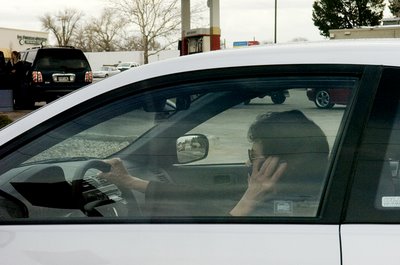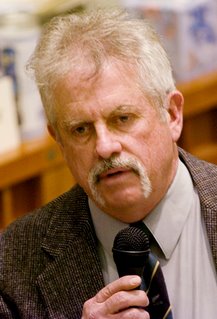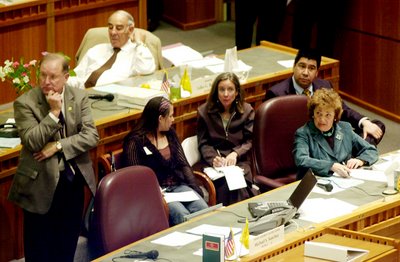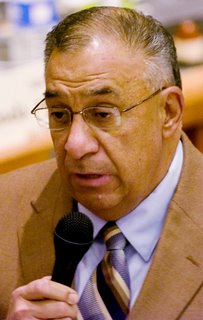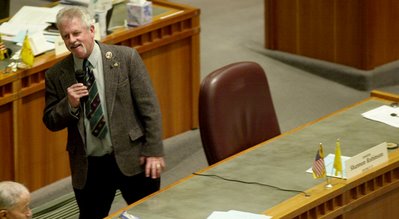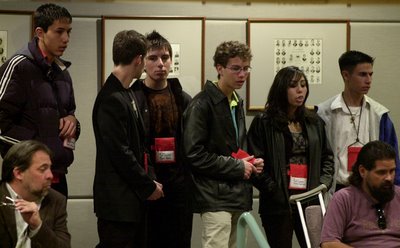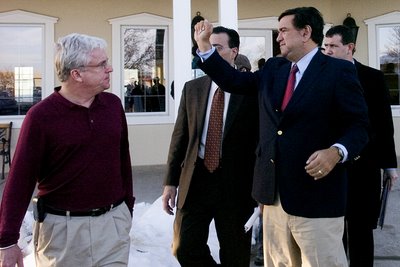What's wrong with this picture?
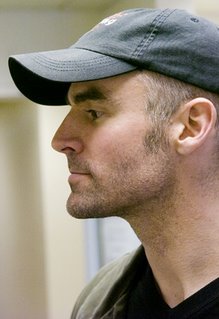
This is the new face of multi-media journalism, Michael Amedeo.
The Albuquerque Tribune http://www.abqtrib.com/ has started using video to augment their coverage, particularly with regards to interviewing candidates.
Editor in Chief Phill Casaus visited my intermediate reporting class at the University of New Mexico, last semester, on Oct. 24. He expressed an interest in adding an online video component to their Web site. This is an exciting proposition and an effective use of an emerging medium; web casting.
I gave him a resume and sent a portfolio, as I am interested in a part time job in the visual communications field. I thought that because the Tribune was going to limit its use of video, this would suit both of us well.
At the end of my cover letter, I wrote: “If you find yourself unable to offer any positions at this point, I would be available to consult with you about my ideas for developing a video component to the Tribune’s Web site.”
He demurred. Casaus said his reasoning for passing on my offer and resume was that he needed to consider purchasing equipment. He ignored the fact that I offered a package deal. This included my services and a studio in a box of state of the art equipment.
So what's wrong with this picture?
I was prepared to unleash on the Tribune’s efforts as being of amateurish quality. It probably was just sour grapes on my part.
I held off because the Tribune’s on-line video guru was scheduled as a guest speaker at my advanced reporting: multi-media class Wed.
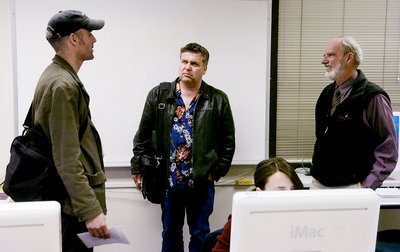
Amedeo is a man who does not use his last name, Tumolillo and who, for the last four weeks, has been working on getting video on the Tribune’s web page, as an adjunct to their print edition. He is talking with my classmate, James W. Snyder at http://premwriter.blogspot.com/ and our professor Dennis Herrick after Amedeo’s presentation.
Amedeo related some of the technical problems with software he is attempting to overcome, especially with compression of video; making files smaller so they will easily show over the Internet.
He’s one of the young breeds: talented, smart, resourceful and full of energy.
He received a bachelor’s degree in English from the University of Oklahoma in 1998 and a Master of Science in Journalism from the Medill School of Journalism at Northwestern University in 2004, just before joining the Tribune staff as a reporter.
He’s one of those people who makes you pause and who unknowingly reminds you of your age. When you realize that you created your first video product three years before he was born, you look back on all your experiences, remembering how much you learned over such a very long period of time. The idea that going to school teaches one what they need to know is such a fallacy. Finishing school actually only prepares one to begin to learn, without the training wheels. I’m always amazed when I look back at all the things I’ve learned since the time I was led to believe I knew it all. What that view has taught me is the realization of how much I must not know and how little of it I’m likely to learn.
As I review the Tribune’s video work, I offer the following critique:
There are three areas: composition/ framing, lighting and sound, that are of major concern.
The Tribune’s school board candidate interviews show a progression of a trial and error learning curve.
The fact that well qualified still photographers were pressed into service is a start. However, they fell down on the basics of lighting an interview, by failing to follow the three-point or Rembrandt’s golden triangle lighting technique.
These interviews were over lit, especially with lighting the background for the head on shot, because it blew out the scene. The automatic exposure sensor of the video misread the scene, consequently trying to bring the bright area into its limited exposure range and by doing so, it inadvertently darkened the skin tones.
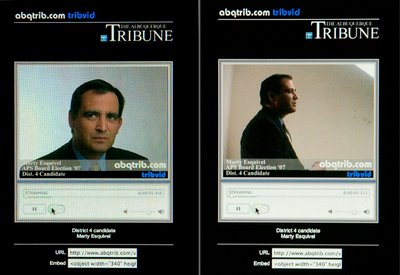
In the Marty Esquivel interview, as an example, the background is too bright, making his facial tones dark.
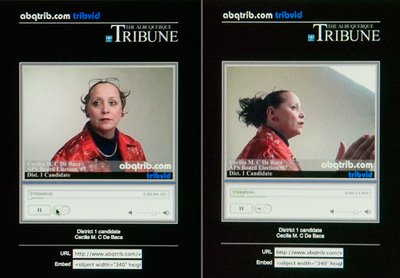
The C De Baca interview was more evenly lit and looked good. However, it has other problems related to framing.
The framing issue is greatest when shifting camera positions. The angle changes, from a head on shot, to a 90-degree profile, where the head size stayed virtually the same, are a problem. When I mentioned it to Amedeo he asked, “did it bother you?” I responded, that it did, and “then there was the rule.”
“There’s a rule,” he asked? That’s when I realized how much he was simply operating on raw talent.
In the visual community this kind of visual edit is called a jump cut or a junk cut. There is a rule that such changes require that the particular image change size by at least a third. Either the head is a third larger or a third smaller as compared to the shot before.
In the Esquivel interview, the head size framing issue is good.
The interview with Gov. Bill Richardson was an absolute mess. There was no effective lighting strategy in the governor’s office. I suspected that there was no trained or experienced photographer present, as the camera was simply pointed in the general direction of Richardson and left to run. Amedeo admitted he shot the video.

There was a huge amount of daylight streaming through an office window from the right side of the scene; the rest of the room was standard office lighting, Amedeo said. Failure to bring and set up lights caused the image to be very muddy. Compression software added to degrading the quality of the picture, Amedeo said.
If the technology is going to introduce problems, all the more reason to get the highest quality image possible.
The new video cameras are extremely seductive. They are capable of producing images that, us old-timers could only hope for from cameras in a fully lit studio. However, no matter how good the potential is, high production quality, lighting and sound, must be added to the incredible capabilities of the new technology.

These are some screen shots of videos with strong window light I have lit for UNM course work. The shot on the left is of Dan Vukelich, a one time Tribune editor who went on to be an investigative producer at KOB TV Eyewitness News and is now the publisher and producer of New Mexico Golf – TV at http://www.newmexicogolftv.com/. The picture on the right is of Professor and Associate Dean for Academic Affairs at the University of New Mexico School of Engineering Charles Fleddermann, in his corner sun-drenched office. In both cases, the lighting was evened out and the picture improved from the ambient light.
The common thread of the Tribune’s error is with sound acquisition. Their approach was obviously to go on the cheap. The use of a single microphone, rather than using individual audio pick-ups for each participant, degraded the quality of their product. It was so bad that when the transcript of the interview was published, words were altered. An example: in answering the final question, Richardson was quoted in the transcription as saying, “…How can it help? Well, there's a lot of Hispanics in this country that may take some pride that one of their own is vying for president.” When in fact he said, “…that one of their own is running for president.”
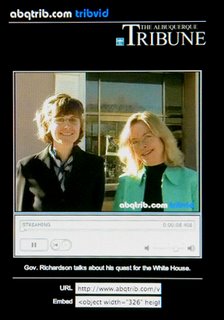
Tribune Managing Editor Kate Nelson, to the right side of the picture and Santa Fe Capitol Correspondent Kate Nash, two seasoned political reporters, had a sit down interview with Richardson in what should have been a premier piece. They asked good questions. However, the resulting video was a less than stellar audio and visual effort.
This was an admittedly rare opportunity to interview the elusive governor, but now that Richardson has announced his run for the Democratic presidential nomination, the greatest effort should have been made to produce a professional product. This video adds little over the print version. The editorial decision to run poor quality exposes a weak position, not one of strength. There comes a time when, as an editor, you simply have to admit that your journalist blew the assignment. It maybe a very difficult decision to own up to, but one of the distinctions between a professional and an amateur is that a professional won’t show you his bad work.
At a minimum, a small portable three instrument lighting kit, with stands, is required. It is an additional 10 pounds, but worth its weight in gold and golden light. Lighting a scene so that it doesn’t look like it has been lit, is an art form unto itself.
The Tribune also needs to invest in a variety of microphones, including four or five lavalieres and maybe a couple of wireless units, along with a portable audio mixer. Capturing good quality sound is also an art form.
Video work is not simply placing a camera in front of a subject. Letting a camera run as a reporter often does with a tape recorder, in order to capture accurate notes at a press conference or interview, is different. Video is a manned activity with a trained and experienced operator who can enhance the storytelling by controlling the camera. As Richardson moved, the camera did not follow. The wide-angle setting of the lens was set up to allow the governor to move around. Camera technique should replicate how humans interact while listening intimately to another person. If they move, the listener’s eyes will track the speaker. The camera should not be static.
There is a whole subset of skills associated with creating compelling video, that do not directly translate from still photography and definitely not from print media; radio experience will often time cover the sound component.
"We teach people how to write essays from the beginning of their schooling . . . but we don't teach people how to express themselves with media," said Elizabeth Daley, professor and dean of the University of Southern California School of Cinema-Television. "I think for anyone today in any field, you need to be able to do that. You also need to be able to understand how media works, because otherwise, you'll misread it all the time," Amedeo wrote, in a Jan. 16, 2006, article with an accompanying video clip for the Tribune, found on his web page http://www.michaelamedeo.com/.

Daley, spoke about the need for everyone to learn the language of the screen, in her presentation, “Multimedia Literacy,” as keynote speaker at the New Mexico Media Industries Strategy Project conference, held in early Jan. Amedeo’s video clip was fraught with the very problems she advocated overcoming. There was a great deal of distracting background noise and Daley was in a bad backlit situation.
Taking control of the environment: lighting it and acquiring good sound and using a tripod all increase the ease for the viewer to receive the information.

Here is an example of a conference situation where I took the head of the Experimental Program to Stimulate Competitive Research at the National Science Foundation, Dr. Sherry O. Farwell, left, into a separate room to interview him.
Dr. Sanjay Krishna, right, a UNM School of Engineering Associate Professor for Electrical and Computing Engineering at the Center for High Technology Materials, granted me an interview in one of his labs, where there was florescent lighting and a low hum from the equipment. By adding some lights and attaching a lavaliere microphone on his shirt, close to his mouth, the video looked and sounded good.
One might think that a major news outlet, like the Tribune, would understand the value of using a professionally trained and experienced videographer. I suspect Amedeo and his colleagues will improve fairly quickly through hit or miss.
I applaud the Tribune’s efforts. The elimination of the trial and error process might be expedited if Casaus were to reconsider my offer.
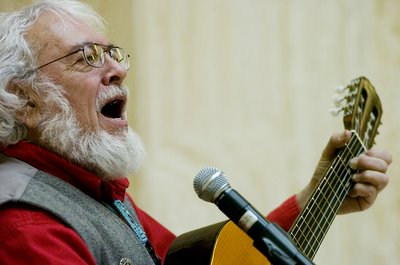 This is former Lt. Gov. Roberto Mondragon in the rotunda on “Native American day,” as he spoke about the importance of water to New Mexicans, then played a guitar and sang for the assembled crowd.
This is former Lt. Gov. Roberto Mondragon in the rotunda on “Native American day,” as he spoke about the importance of water to New Mexicans, then played a guitar and sang for the assembled crowd.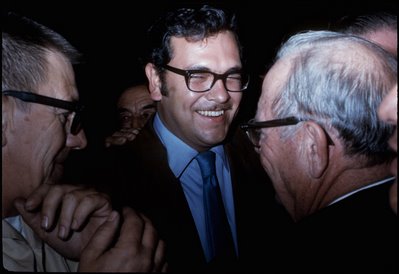 This is election night 1970, when Mondragon learned that the local television stations had just projected that he and King had been elected. He looks like a kid; he probably was.
This is election night 1970, when Mondragon learned that the local television stations had just projected that he and King had been elected. He looks like a kid; he probably was. 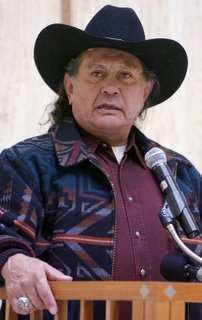 This is Russell Means of San Jose, N.M. This was the first time I photographed Means, though I have followed his politics back to the early 1970s, when he was a prominent leader of the American Indian Movement. AIM was known for several high-profile acts of civil disobedience, taking over public places including, Mount Rushmore, S.D. in 1970, Wounded Knee on the Pine Ridge Indian Reservation, S.D. in 1973, and the Bureau of Indian Affairs offices in Washington, D.C. in 1973.
This is Russell Means of San Jose, N.M. This was the first time I photographed Means, though I have followed his politics back to the early 1970s, when he was a prominent leader of the American Indian Movement. AIM was known for several high-profile acts of civil disobedience, taking over public places including, Mount Rushmore, S.D. in 1970, Wounded Knee on the Pine Ridge Indian Reservation, S.D. in 1973, and the Bureau of Indian Affairs offices in Washington, D.C. in 1973.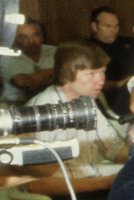 My associate and fellow blogger Joe Monahan calls “La Politico” an addiction. Monahan claims that when it gets into people’s blood, there is no known cure.
My associate and fellow blogger Joe Monahan calls “La Politico” an addiction. Monahan claims that when it gets into people’s blood, there is no known cure.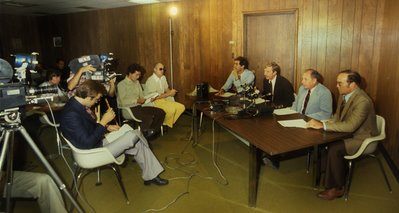 What this makes me realize is that time marches on and we all are getting older.
What this makes me realize is that time marches on and we all are getting older.
